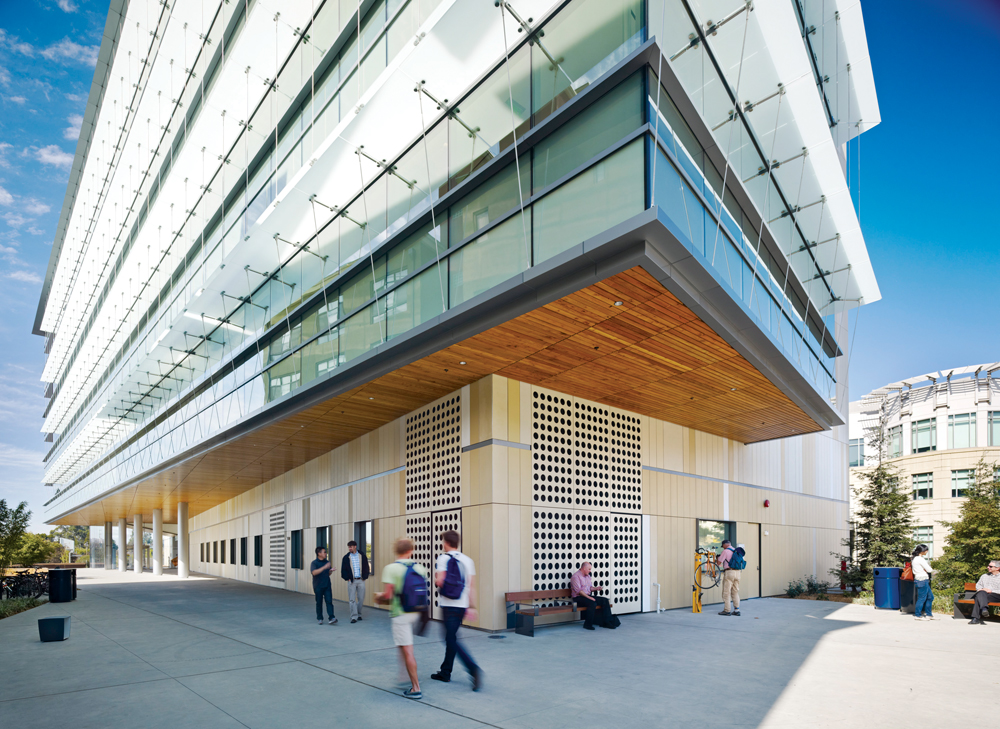After an era of biology-oriented spending—largely driven by Big Pharma and government concerns about bioterrorism—climate change is reshaping priorities in science and technology construction. “Engineering and chemistry funding are going up now, as is energy research, which seems to continue to get federal funding,” says Andy Vazzano, FAIA, LEED AP, Science and Technology Practice Leader at SmithGroupJJR. “Meanwhile, the sequester and budget cuts are having a negative impact on NIH funding for biomedical research.”
The focus on human health hasn’t totally faded, with many research universities still building new labs—especially those that tie research to clinical practice. “Anything that begins with ‘trans’ or ‘inter’ is still a major trend,” says Ryan Abbott, Science and Technology Project Director at Sundt Construction and a BD+C “40 Under 40” honoree (Class of 2012). “Translational, interdisciplinary. Modern science is a team sport.”
TOP S&T SECTOR ARCHITECTURE FIRMS
2012 S+T Revenue ($)1 HDR Architecture $91,252,0002 Perkins+Will $48,373,5683 HOK $38,347,0004 Stantec $33,111,4695 SmithGroupJJR $26,400,0006 Flad Architects $21,480,0007 Payette $18,434,0298 ZGF Architects $16,214,2679 EwingCole $11,000,00010 FKP Architects $10,250,000
TOP S&T SECTOR ENGINEERING FIRMS
2012 S+T Revenue ($)1 Affiliated Engineers $19,824,0002 Middough $13,900,0003 URS Corp. $11,772,1244 Bard, Rao + Athanas Consulting Engineers $10,500,0005 RMF Engineering Design $9,200,0006 Vanderweil Engineers $7,851,9007 Paulus, Sokolowski and Sartor $7,500,0008 WSP USA $5,772,0959 Science Applications International Corp. $3,103,15210 STV $2,937,000
TOP S&T SECTOR CONSTRUCTION FIRMS
2012 S+T Revenue ($)1 Skanska USA $376,717,4742 DPR Construction $298,563,6423 Suffolk Construction $290,560,3074 Manhattan Construction $199,444,0005 Whiting-Turner Contracting Co., The $193,160,4256 JE Dunn Construction $184,799,0517 Clark Group $174,348,8048 Turner Corporation, The $157,490,0009 Structure Tone $143,798,00010 Consigli Construction $74,568,263
Though the purpose-built med school building is the iconic face of S+T, adaptive reuse is getting a second look for advantages in cost and speed. Many clients are also seeking higher levels of green; LEED Platinum, once thought impossible for labs, is no longer unique, and clients are increasingly eyeing net-zero.
In addition, look for public/private partnerships to assume a greater role, even in the rarefied atmosphere of the Ivy League. Harvard, for instance, has rethought its Allston science campus during a recession hiatus. When the site cranks up again next year, the program will include a 36-acre, privately developed “enterprise research campus” for related companies in pharma, biotech, and venture capital.
Read BD+C's full Giants 300 Report
Related Stories
| Mar 2, 2011
How skyscrapers can save the city
Besides making cities more affordable and architecturally interesting, tall buildings are greener than sprawl, and they foster social capital and creativity. Yet some urban planners and preservationists seem to have a misplaced fear of heights that yields damaging restrictions on how tall a building can be. From New York to Paris to Mumbai, there’s a powerful case for building up, not out.
| Mar 1, 2011
Smart cities: getting greener and making money doing it
The Global Green Cities of the 21st Century conference in San Francisco is filled with mayors, architects, academics, consultants, and financial types all struggling to understand the process of building smarter, greener cities on a scale that's practically unimaginable—and make money doing it.
| Mar 1, 2011
How to make rentals more attractive as the American dream evolves, adapts
Roger K. Lewis, architect and professor emeritus of architecture at the University of Maryland, writes in the Washington Post about the rising market demand for rental housing and how Building Teams can make these properties a desirable choice for consumer, not just an economically prudent and necessary one.
| Mar 1, 2011
New survey shows shifts in hospital construction projects
America’s hospitals and health systems are focusing more on renovation or expansion than new construction, according to a new survey conducted by Health Facilities Management magazine and the American Society for Healthcare Engineering (ASHE). In fact, renovation or expansion accounted for 73% of construction projects at hospitals responding to the survey.
| Mar 1, 2011
AIA selects 6 communities for long-term sustainability program
The American Institute of Architects today announced it has selected 6 communities throughout the country to receive technical assistance under the Sustainable Design Assessment Team (SDAT) program in 2011. The communities selected are Shelburne, Vt., Apple Valley, Mn., Pikes Peak Region, Co., Southwest DeKalb County, Ga., Bastrop, Tx., and Santa Rosa, Ca. The SDAT program represents a significant institutional investment by the AIA in public service work to assist communities in developing policy frameworks and long term sustainability plans.
| Feb 24, 2011
Perkins+Will designs 100 LEED Certified buildings
Perkins+Will announced the Leadership in Energy and Environmental Design (LEED) certification of its 100th sustainable building, marking a key milestone for the firm and for the sustainable design industry. The Vancouver-based Dockside Green Phase Two Balance project marks the firm’s 100th LEED certified building and is tied for the highest scoring LEED building worldwide with its sister project, Dockside Green Phase One.
| Feb 24, 2011
New reports chart path to net-zero-energy commercial buildings
Two new reports from the Zero Energy Commercial Buildings Consortium (CBC) on achieving net-zero-energy use in commercial buildings say that high levels of energy efficiency are the first, largest, and most important step on the way to net-zero.
| Feb 24, 2011
Lending revives stalled projects
An influx of fresh capital into U.S. commercial real estate is bringing some long-stalled development projects back to life and launching new construction of apartments, office buildings and shopping centers, according to a Wall Street Journal article.
| Feb 23, 2011
London 2012: What Olympic Park looks like today
London 2012 released a series of aerial images that show progress at Olympic Park, including a completed roof on the stadium (where seats are already installed), tile work at the aquatic centre, and structural work complete on more than a quarter of residential projects at Olympic Village.
| Feb 23, 2011
Call for Entries: 2011 Building Team Awards, Deadline: March 25, 2011
The 14th Annual Building Team Awards recognizes newly built projects that exhibit architectural and construction excellence—and best exemplify the collaboration of the Building Team, including the owner, architect, engineer, and contractor.










